# AERODYNAMIC BALANCING:
Table of Contents:
- What Is Aerodynamic Balancing?
- Methods Used For Aerodynamic Balancing
- Set-Back Hinge Balance
- Horn Balance
- Internal Balance
- Beveled Trailing Edge
- Tab
What Is Aerodynamic Balancing?
The floating characteristics of a control surface depend on the hinge-moment characteristics and, the stick force also depends on the hinge moment characteristics. Too low values of the hinge-moment would make the controls highly sensitive to small disturbances, whereas too high values would make the controls sluggish to operate. Therefore, a careful design of the hinge moment parameters Chα and Chδ is necessary to achieve a proper balance between these two conflicting requirements. The control of hinge moment parameters Chα and Chδ is called the aerodynamic balancing.
Methods Used For Aerodynamic Balancing:
There are mainly five methods to avoid aerodynamic balancing and are as follows,
- Set-Back Hinge Balance
- Horn Balance
- Internal Balance
- Beveled Trailing Edge
- Tab
1. Set-Back Hinge Balance (Aerodynamic Balancing):
When the hinge line is at the control surface leading edge, both Chα and Chδ are negative. If the hinge line is moved further aft, both Chα and Chδ become more positive because the control surface forward of the hinge line produces an opposing moment to that produced by the surface aft of the hinge line. The net hinge moment, which is the algebraic sum of these two moments, is greatly reduced. This type of aerodynamic balancing is called set-back hinge balance.
However, one has to be careful because too much area forward of the hinge line may lead to an overbalance of the control at some flight conditions that may affect the pilot’s feel of the aircraft. The below figure shows the effect of set back hinge balance on Chα and Chδ with cb / cf.– NACA 0015 airfoil with blunt nose and sealed gap.

It may be added that the changes in Chα and Chδ also depend on the below points,
- Gap between nose of the control surface and the main surface
- Nose shape
- Trailing edge angle
The below figure shows the parameters of control surface – chord lengths.
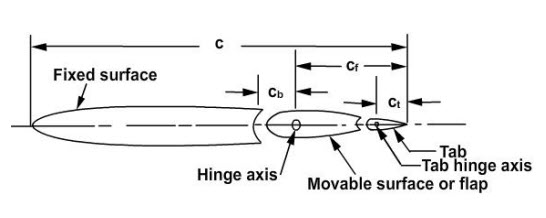
The below figure shows the parameters of control surface- shapes of nose and trailing edge.
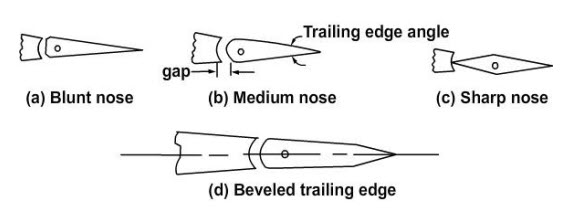
2. Horn Balance (Aerodynamic Balancing):
Horn balance is similar to the set-back hinge, except that all the area ahead of the hinge line is concentrated on one part of the surface. The horn balance makes both Chα and Chδ less negative though the effect on Chδ is more pronounced than in the case of set-back hinge method. The following parameters are used to describe the effect of horn balance on Chα and Chδ.

There are two types of horn balances – shielded and unshielded.

The below figure shows the areas of the horn and control surface.
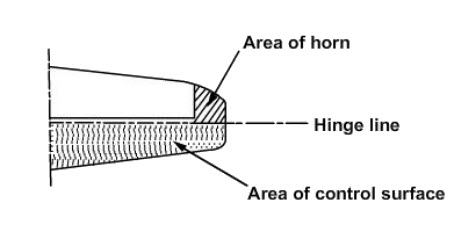
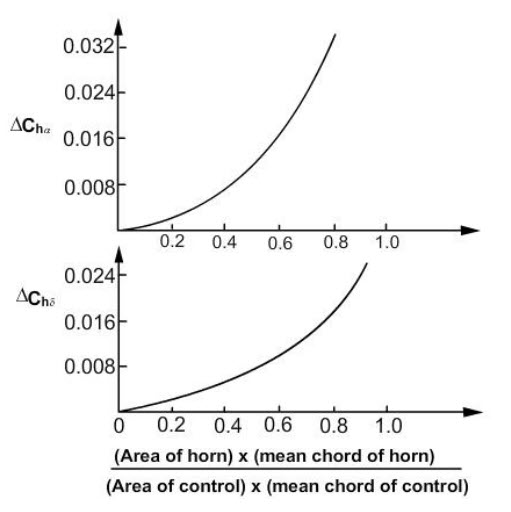
Horn balance is sometimes used on the horizontal and vertical tails of the low speed airplanes.

3. Internal Balance (Aerodynamic Balancing):
The internal balance is a modification of the set-back hinge method. The inside of the airfoil has to be vented to the external pressures so that the pressures acting on the balancing area provide the necessary balancing effect. The effectiveness of this balance can be increased by sealing the gap between the leading edge of the control surface and the structure of the airfoil as shown in the below figure.
The amount of balance can be adjusted by properly venting the seal. This type of balance has a greater effect on Chδ than on Chα. A seal at the leading edge of the projecting portion ensures that the pressures on the two sides of the projection do not equalize. This method of aerodynamic balancing is complex but is reliable. It is used on large airplanes to reduce Chα and Chδ.
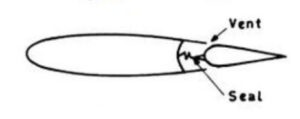
Internal seal and the changes ΔChα and ΔChδ as compared to control surface with cb / cf = 0.
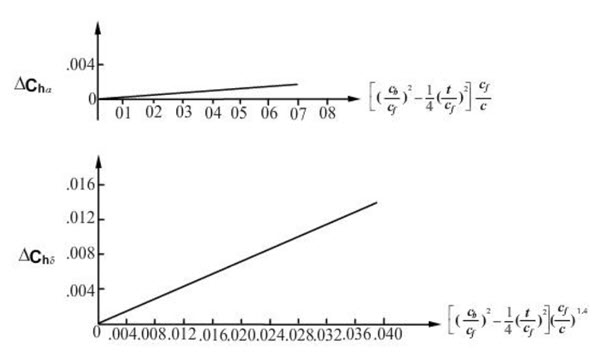
4. Beveled Trailing Edge (Aerodynamic Balancing):
The shapes of the leading and trailing edges of the control surface also have an effect on the hinge moment parameters Chα and Chδ. For example, beveling the trailing edge alters the parameter Chδ because the pressure distribution over the control surface is altered.

5. Tab (Aerodynamic Balancing):
The above methods of balancing (except the beveled trailing edge) are based on pressure changes on the control surface ahead of the hinge line. An alternative way of balancing the control surface is by deploying an additional control surface called “tab“. The tab is much smaller in size compared to the elevator and is usually deflected in the opposite direction as shown in the below image.
Even though the tab is small in size, the pressure changes caused by its deflection produce appreciable moments about the elevator hinge line. Because the tab moves only when the elevator moves, it has little or no effect on Chα . The tab has the added advantage that it can always provide just the right amount of balancing as needed. Hence, it has a minor disadvantage that an opposite of the tab results in a small lift loss, hence a reduction in overall control effectiveness. This type of tab is also known as a trim tab because it is used to trim the stick forces.
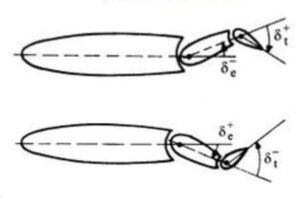
To find more topics on our website…
Do you want to refer wikipedia? Please click here…
